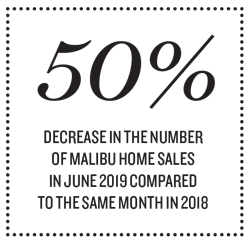California’s wildfire season traditionally starts in midsummer and ends in early fall, but it may soon last much longer: The National Climate Assessment forecasts that the area burned by wildfires will double nationwide in the next 25 years as global warming causes more droughts and longer wildfire seasons. In communities like Malibu, which was hit by the devastating Woolsey Fire in November 2018, that reality is causing homeowners and developers alike to do everything in their power to protect against future blazes.
Though Malibu has survived at least 30 wildfires in the last 90 years — including one in 1996 that claimed 10 homes and another in 2007 that engulfed 53 houses —the Woolsey Fire was unprecedented in terms of its magnitude. A total of 550 homes were destroyed in the city, with an additional 187 properties damaged in some manner.
RELATED STORIES
— How one home survived the Woosley Fire
— Price on cliffside Malibu estate slashed again
— Scott Gillen’s luxury Malibu cliffside community has 1st home in contract
— A Day in the Life of Scott Gillen
In neighborhoods like Malibu Park, where the damage was most severe, more than 25 percent of the housing inventory was destroyed. “It was unprecedented, not only in scale but in how fast it moved,” said Sandro Dazzan, a Realtor with the Agency who was born and raised in Malibu. “To see a fire cover that much ground in a matter of hours was astonishing.”
Home sales naturally slowed in the aftermath of the fire. Sales this June were down 50 percent in both total dollar volume sold and number of units compared with June 2018, according to data provided by the Agency. From January to June of 2018, there were 152 units sold in Malibu. Over first half of 2019, that number dropped to 81, the brokerage found.
 Despite the initial slowdown, there have been some significant sales in recent weeks — most were new construction, high-end beach properties or both. A three-bedroom, 2,273-square-foot bluffside property on Point Dume closed for $21.75 million, or nearly $10,000 per square foot. And a 3,800-square-foot fixer-upper on Carbon Beach went for $19.1 million after fielding multiple offers. Around 17 homes have gone into escrow since Jan. 1, including a spec home, listed at $14.25 million, that is still five months from completion.
Despite the initial slowdown, there have been some significant sales in recent weeks — most were new construction, high-end beach properties or both. A three-bedroom, 2,273-square-foot bluffside property on Point Dume closed for $21.75 million, or nearly $10,000 per square foot. And a 3,800-square-foot fixer-upper on Carbon Beach went for $19.1 million after fielding multiple offers. Around 17 homes have gone into escrow since Jan. 1, including a spec home, listed at $14.25 million, that is still five months from completion.
Though it will take time for the market to recover, these strong sales are evidence the fire has not deterred buyers. “Malibu is still Malibu,” said Ginger Escobar, a Realtor with Pritchett-Rapf. “People were concerned after the fire, but the beauty of the location and the sense of community here continue to draw people back. The land is starting to heal, and people are starting to rebuild.”
The renewal effort
The city of Malibu has taken an active role in the recovery process by hosting town hall meetings and workshops to help homeowners with paperwork. It has also created an expedited permitting process and waived permitting fees for “like for like” rebuilds that are roughly the same footprint and square footage as homes lost in the fire. In its recently passed budget, Malibu’s City Council set public safety as the No. 1 priority and Woolsey Fire recovery as the second priority for the coming year. It is currently working on an ordinance that, if implemented, would prohibit highly flammable nonnative vegetation within Woolsey Fire reconstruction projects.
“Fire and building codes have changed over the years to require fire-resistant glazing, roofing, siding and landscaping,” said Karen Farrer, mayor pro tem for the city. “The code now requires fire sprinklers and fuel modification plans, where homeowners have to show that they have created defensible space and reduced highly flammable materials that could ignite the home.”
The new rules will likely alter the looks of the homes that will rise in the area.
“I think you will see a lot more modern-style homes with stone, brick or stucco exteriors, triple-paned tempered glass windows and no exposed wood,” said Realtor Mike Gardner of Sotheby’s International Realty Malibu. “We’ll see big cement patios and walkways wrapping around the base of the homes instead of planting beds that can accumulate flammable material.”
 Abeer Sweis, founder and partner at the design and construction firm SweisKloss and one of L.A.’s leading designers of fire-resistant homes, has long explored how materials like concrete, stucco and metal roofs can reduce the risk of fire damage.
Abeer Sweis, founder and partner at the design and construction firm SweisKloss and one of L.A.’s leading designers of fire-resistant homes, has long explored how materials like concrete, stucco and metal roofs can reduce the risk of fire damage.
“We design a lot of hillside homes, and those are typically in severe high fire zones,” she said. “We use both passive design, like building siting and defensible space, as well as active systems like sprinkler systems, foam and fire curtains and shutters.”
Local developer Scott Gillen took things a step further by incorporating individual water cannons for each house in his 24-acre, five-home project known as the Case. Meanwhile, architect Doug Burdge of Burdge & Associates Architects is lobbying to have some of Malibu’s building codes changed so that more water can be stored on site in underground cisterns or tanks.
“Malibu’s building codes were already strict because it’s in the highest fire severity zone,” said Joseph Lezama, an associate at Burdge & Associates Architects. “Newer homes are more up to code, with features that leave them less vulnerable to fire. It’s hard to say whether there’s a premium on fire-resistant homes, because most of them aren’t on the market yet.”
According to data provided by the city of Malibu, there are currently 93 single-family residences that have been approved by the planning board and a dozen more waiting for approval. Eight building permits have been issued to rebuild homes that were completely destroyed.
“Much of the initial activity involved fire debris removal, an activity that takes up to a few months to complete since it is highly regulated,” said Farrer. With permits granted and debris removed, homeowners are now starting to turn their attention to the actual rebuilding process. “It’s not our first fire, and unfortunately it won’t be our last,” Dazzan said. “[But] we’re already starting to rebuild, and rebuild even stronger.”
